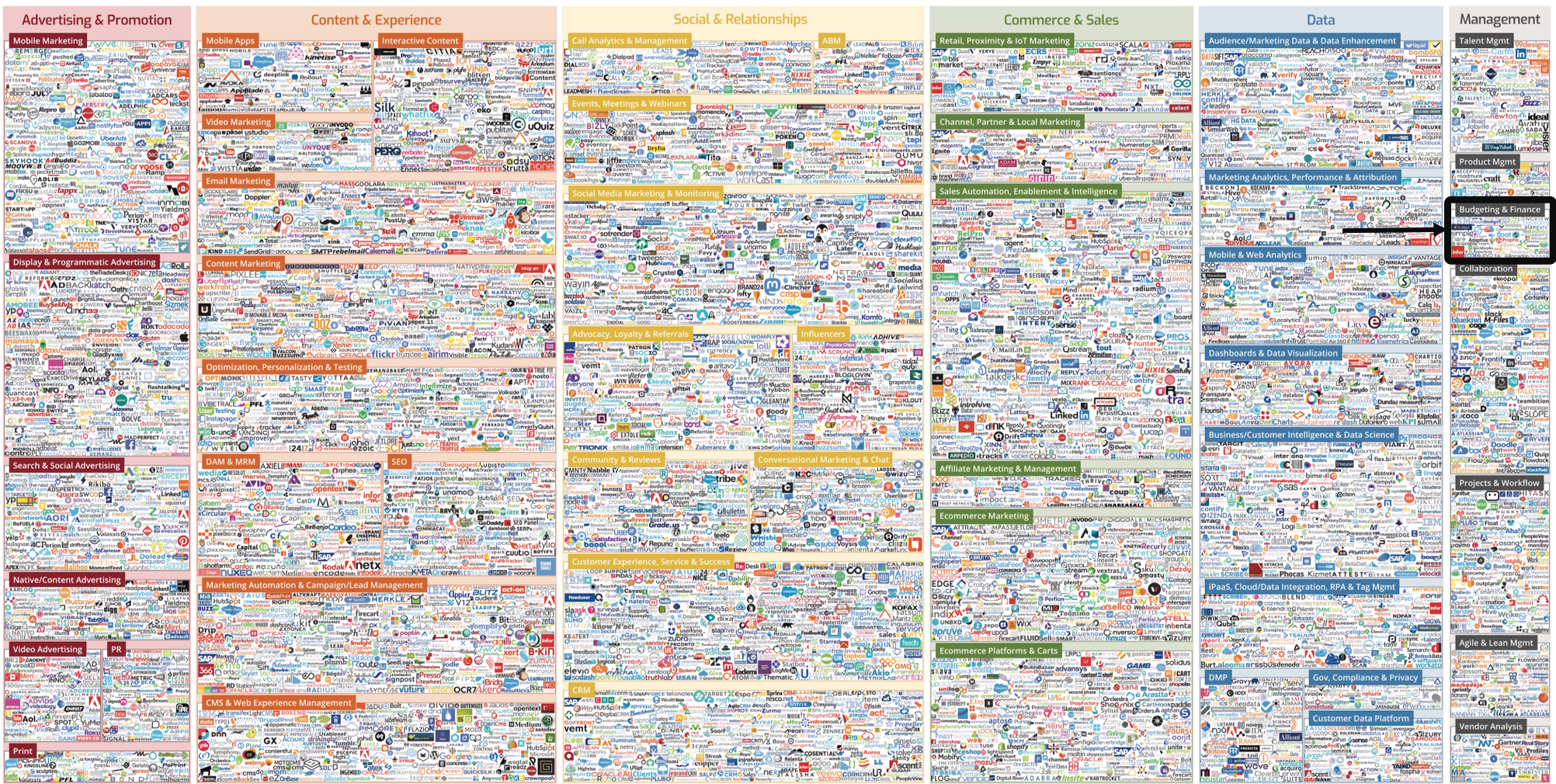The hidden, frequent, marketing budget error – and how to avoid it

MarTech simultaneously makes us scientists, artists and luddites
Marketing is an uneven discipline. In some respects, it is wildly sophisticated, such as the technical innovation in response to the explosive growth of digital marketing and advertising. The MarTech landscape has become so complex that new technologies have emerged just to make sense of it (cf. our Glasswing stablemate, Cabinet M). AI has been embraced to handle the enormous volume and velocity of data generated by the digital Big Bang.
And then there are budgets. Marketing budget management (MBM) remains astoundingly basic. The largest discretionary corporate expenditure in the world ($1T p.a. and growing) continues to be managed primarily on generic spreadsheets, separated from the strategic marketing plan and goals. Significant errors are tolerated in marketing in a way that they’re not in other functions. For marketing to maintain its credibility as a function, it badly needs to modernize its approach to budget management.
In Scott Brinker’s MarTech landscape, we can see that Budgeting and Finance occupies a small proportion of the overall landscape:

If you look closer, the majority of the companies in this section of the landscape don’t actually have budgeting capabilities (i.e. they’re largely product management or project management tools) or they’re generic tools vs specialized marketing tools. Marketing budgets are special: they’re uniquely complex, fast-moving, have multiple team members with buying authority, and are hugely diverse. So it’s not surprising that errors creep in. It’s not completely surprising that budget wastage is self-reported by CMO’s at 26%, as I wrote about wasting marketing budget.
It’s easy to miss mistakes in a marketing budget
My goal in this post is to share some insights that we have gleaned at Planful about the myriad ways that MBM is failing today. These are driven from primary experience helping our customers transfer their budgets from spreadsheets into Planful, and from the recently announced Planful Marketing Graph (PMG).
Of the hundreds of marketing budget spreadsheets we have reviewed, nearly all of them contain errors. These errors have ranged in value from $3,000 to $400,000. Often, these are formula errors (a formula doesn’t pick up a cell, row, or column and it should) or formatting errors (the thing that looks like a number to you looks like text to the spreadsheet). These have been covered by Peter Mahoney, our CEO, in this blog on Excel marketing budget mistakes.
The PMG has shown us that there are more systemic errors that can creep into plans and they can be tough to find. It seems odd to think that a marketer can (1) know they’re over budget but not see where or how and (2) think they’re not over budget when they are, but it is a surprisingly common issue. The first issue is problematic because if you don’t see where you’re over budget – very specifically – you can’t fix it. The second issue is problematic because you will discover too late that you’ve spent too much.
Here’s one of the most common culprits: timeframes. Most companies allocate marketing budget in 2 dimensions:
- by department (e.g. Demand Gen, PR, Marketing Ops…)
- by timeframe (i.e. quarterly or monthly).
Then the departmental budget owners receive their allocations and build a plan against their budget targets. The most common error we see in the PMG is violation of these original allocations. Imagine a company in which the CMO allocates $50K per quarter to demand gen. The demand gen manager sees that he has $200K to spend in total and sets up a major Q2 campaign that’s going to cost $100K. Is the demand gen manager’s plan over budget? You bet – by 100%. It’s not over budget at all on an annualized basis, but it’s badly over budget in Q2. And it’s going to be underspent in other quarters, which may present additional issues. Concentration of investments is a topic for another blog. The point is that this kind of budget error happens, and happens a lot. Many companies – both public and private – have to adhere to strict P&L plans on a quarterly basis. This kind of budgeting error can cause serious governance issues, given how significant marketing budgets are for many companies.
In a perfect world, the demand gen manager would work with the CMO, and either change the plan to stick to the original allocation of $50K per quarter, or the CMO would agree to change allocations and somehow accommodate the $100K spend in Q2. Very frequently, though, this does not happen. Even if the marketing campaigns are successful, the financial errors can leave a bad taste at the corporate level. This type of error is among the most common we see.
It’s incredibly easily done too, especially when there are integrated campaigns that require efforts and investment across multiple teams and multiple time periods. This type of error can be almost impossible to spot in a spreadsheet, until it is too late. Just this week we were working with a customer who sent us a screenshot of their plan, saying “None of my campaigns are over budget…how come the plan is showing over budget?” and it was precisely this issue. Fortunately, they were working in Planful, and Planful did pick it up.
Marketing budgets are special – treat them accordingly
Marketing drives tremendous business value. That’s why it commands such significant investment. Every budget error degrades that value: overspend damages the P&L; wastage sub-optimizes the investment; underspend reduces business impact. It’s more critical than ever that marketers have real-time visibility into what they’ve spent, what’s left to spend, and how the budget is allocated in time over the financial year, to squeeze every drop of value from their marketing investments in a hyper-competitive world.
Learn more about our marketing planning software.
Latest Posts
Blogs
Interviews, tips, guides, industry best practices, and news.
